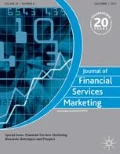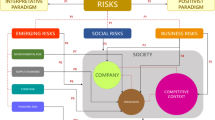Abstract
Knowledge and risks have a focal role in consumer behavior. However, studies on consumers’ perceive risks in decision situations and the influence of objective knowledge and experience on risk perceptions, consumers’ attitudes and behavioral intentions are scarce. This paper introduces and tests a novel conceptual model that shows how consumers’ objective financial knowledge and investing experience affect their future investment intentions mediated by perceived risks, and attitudes toward investing. The data were analyzed using structural equation modeling. The proposed model fits the data and accounts for attitudes and intentions to investing. This study advances knowledge by directly measuring the behavior-related objective knowledge and experience. We also suggest new insights into the risk concept by showing that consumers perceive five types of risk in investing context and objective financial knowledge and investment experience has varying effects on different risks types, attitudes and intentions. The results also show significant gender differences.


Similar content being viewed by others
References
Ajzen, I. 1989. Attitude, structure and behavior. In Attitude, structure and function, ed. A.R. Pratkanis, S.J. Breckler, and A.G. Greenwald. Hillsdale, NJ: Lawrence Erlbaum Associates.
Ajzen, I. 1991. The theory of planned behavior. Organizational Behavior and Human Decision Processes 50(2): 179–211.
Ajzen, I., and M. Fishbein. 1980. Understanding attitudes and predicting social behaviour. New York: Englewood-Cliffs.
Alba, J., and J. Hutchinson. 1987. Dimensions of consumer expertise. Journal of Consumer Research 13(4): 411–454.
Aldás-Manzano, J., C. Lassala-Navarré, C. Ruiz-Mafé, and S. Sanz-Blas. 2009. The role of consumer innovativeness and perceived risk in online banking usage. International Journal of Bank Marketing 27(1): 53–75.
Aspara, J., and H. Tikkanen. 2010. The role of company affect in stock investments: Towards blind, undemanding, noncomparative and committed love. Journal of Behavioral Finance 11(2): 103–113.
Bell, S., and A. Eisingerich. 2007. The paradox of customer education: Customer expertise and loyalty in the financial services industry. European Journal of Marketing 41(5/6): 466–486.
Boisvert, J., and N. Ashill. 2011. How brand innovativeness and quality impact attitude towards new Service line extensions: The moderating role of consumer involvement. Journal of Service Marketing 25(7): 517–527.
Bostrom, A., B. Fischhoff, and G. Morgan. 1992. Characterizing mental models of hazardous process: A methodology and an application to radon. Journal of Social Issues 48(4): 85–100.
Browne, M., and R. Cudeck. 1993. Alternative ways of assessing model fit. Sociological Methods & Research 21(2): 230–258.
Brucks, M. 1985. The effects of product class knowledge on information search behavior. Journal of Consumer Research 12(1): 1–16.
Chang, C. 2004. The interplay of product class knowledge and trial experience in attitude formation. Journal of Advertising 33(1): 83–92.
Cho, J., and J. Lee. 2006. An integrated model of risk and risk-reducing strategies. Journal of Business Research 59(1): 112–120.
Davidson, A., S. Yantis, M. Norwood, and D. Montano. 1985. Amount of Information About the Attitude Object and Attitude-Behavior Consistency. Journal of Personality and Social Psychology 49(5): 1184–1198.
Fabrigar, L., S. Smith, R. Petty, and S. Crites. 2006. Understanding knowledge effects on attitude-behavior consistency: The role of relevance, complexity and amount of Knowledge. Journal of Personality and Social Psychology 90(4): 556–577.
Fischhoff, B. 1989. Risk: A guide to controversy. In Improving risk communication, ed. National Research Council, 211–319. Washington, DC: National Research Council.
Fonseca, R., K.J. Mullen, G. Zamarro, and J. Zissimopoulos. 2012. What explains the gender gap in financial literacy? The role of household decision making. Journal of Consumer Affairs 46(1): 90–106.
Forsythe, S.M., and B. Shi. 2003. Consumer patronage and risk perceptions in Internet shopping. Journal of Business Research 56(11): 867–875.
Frewer, L., C. Howard, D. Hedderley, and R. Shepherd. 1998. Methodological approaches to assessing risk perceptions associated with food-related hazards. Risk Analysis 18(1): 95–102.
Garbarino, E., and M. Strahilevitz. 2004. Gender differences in the perceived risk of buying online and the effects of receiving a site recommendation. Journal of Business Research 57(7): 768–775.
Grable J. 1997. Investor risk tolerance: Testing the efficacy of demographics as differentiating and classifying factors. Doctoral Dissertation. Virginia Polytechnic Institute and State University.
Hair Jr., J., G. Hult, C. Ringle, and M. Sarstedt. 2014. A primer on partial least squares structural equation modeling (PLS-SEM). Los Angeles: Sage.
Havlena, W.J., and W.S. DeSarbo. 1991. On the measurement of perceived consumer risk. Decision Sciences 22(4): 927–939.
Hovland, C., I. Janis, and H. Kelley. 1953. Communication and persuasion. New Haven, CT: Yale Univeristy Press.
Huang, J., B. Lee, and S. Hsun. 2004. Consumer attitude toward gray market goods. International Marketing Review 21(6): 598–614.
Huang, C. 1993. Simultaneous-equation model for estimating consumer risk perceptions, attitudes, and willingness-to-pay for residue-free produce. Journal of Consumer Affairs 27(2): 377–396.
Jorgensen, B., and J. Savla. 2010. Financial literacy of young adults: The importance of parental socialization. Family Relations 59(4): 465–478.
Kim, D., D. Ferrin, and H. Rao. 2008. A trust-based consumer decision-making model in electronic commerce: The role of trust, perceived risk, and their antecedents. Decision Support Systems 44(2): 544–564.
Klerck, D., and J.C. Sweeney. 2007. The effect of knowledge types on consumer-perceived risk and adoption of genetically modified foods. Psychology & Marketing 24(2): 171–193.
Laroche, M., C. Kim, and L. Zhou. 1996. Brand familiarity and confidence as determinants of purchase intention: An empirical test in a multiple brand context. Journal of Business Research 37(2): 115–120.
Laroche, M., J. Bergeron, and C. Goutaland. 2003. How intangibility affects perceived risk: The moderating role of knowledge and involvement. Journal of Services Marketing 17(2): 122–140.
Leskinen, J., and A. Raijas. 2006. Consumer financial capability-a life cycle approach. In Consumer financial capability: Empowering European consumers, ed. European Credit Research Institute, 8–23. Brussels: European Credit Research Institute.
Lim, K.L., G.N. Soutar, and J.A. Lee. 2013. Factors affecting investment intentions: A consumer behaviour perspective. Journal of Financial Services Marketing 18(4): 301–315.
Littler, D., and D. Melanthiou. 2006. Consumer perceptions of risk and incertainty and the implications for behaviour towards innovative retail services: The case of Internet Banking. Journal of Retailing and Consumer Services 13(6): 431–443.
Löfstedt, R., and O. Renn. 1997. The Brent Spar controversy: An example of risk communication gone wrong. Risk Analysis 17(2): 131–136.
Lu, H.-P., C.-L. Hsu, and H.-Y. Hsu. 2005. An empirical study of the effect of perceived risk upon intention to use online applications. Information Management & Computer Security 13(2): 106–120.
MacGregor, D.G., P. Slovic, D. Dreman, and M. Berry. 2000. Imagery, affect, and financial judgment. Journal of Psychology and Financial Markets 1(2): 104–110.
Mitchell, V.-W. 1999. Consumer perceived risk: Conceptualisations and models. European Journal of Marketing 33(1/2): 163–195.
Nicolini, G., B.J. Cude, and S. Chatterjee. 2013. Financial literacy: A comparative study across four countries. International Journal of Consumer Studies 37(6): 689–705.
Pellinen, A., K. Törmäkangas, O. Uusitalo, and J. Munnukka. 2015. Beliefs affecting additional investment intentions of mutual fund clients. Journal of Financial Services Marketing 20(1): 62–73.
Pellinen, A. 2009. Sijoitusrahastoasiakkaiden taloudellinen kyvykkyys ja tulevat lisäsijoituspäätökset, Dissertation. Jyväskylä: The University of Jyväskylä press.
Pellinen, A., K. Törmäkangas, O. Uusitalo, and A. Raijas. 2011. Measuring the financial capability of investors. International Journal of Bank Marketing 29(2): 107–133.
Pillai, K., and C. Hofacker. 2007. Calibration of consumer knowledge of the Web. International Journal of Research in Marketing 24(3): 254–267.
Pires, G., J. Stanton, and A. Eckford. 2006. Influences on the perceived risk of purchasing online. Journal of Consumer Behaviour 4(2): 1479–1838.
Podsakoff, P., S. MacKenzie, J. Lee, and N. Podsakoff. 2003. Common method biases in behavioral research: A critical review of the literature and recommended remedies. Journal of Applied Psychology 88(5): 879–903.
Ponsignon, F., P. Klaus, and R.S. Maull. 2015. Experience co-creation in financial services: An empirical exploration. Journal of Service Management 26(2): 295–320.
Raju, P., S. Lonial, and W. Mangold. 1995. Differential effects of subjective knowledge, objective knowledge, and usage experience on decision making: An exploratory investigation. Journal of consumer psychology 4(2): 153–180.
Robb, C.A. 2011. Financial knowledge and credit card behavior of college students. Journal of Family and Economic Issues 32(4): 690–698.
Schermelleh-Engel, K., H. Moosbrugger, and H. Müller. 2003. Evaluating the fit of structural equation models: Tests of significance and descriptive goodness-of-fit measures. Methods of Psychological Research Online 8(2): 23–74.
Sen, A. 1993. Capability and well-being. In The quality of life, ed. M.C. Nussbaum and A. Sen, 30–53. Oxford: Clarendon Press.
Simcock, P., L. Sudbury, and G. Wright. 2006. Age, perceived risk and satisfaction in consumer decision making: A review and extension. Journal of Marketing Management 22(3/4): 355–377.
Snoj, B., A. Pisnik Korda, and D. Mumel. 2004. The relationships among perceived quality, perceived risk and perceived product value. Journal of Product & Brand Management 13(3): 156–167.
Solomon, M. 2014. Consumer behavior: Buying, having, and being. Engelwood Cliffs, NJ: Prentice Hall.
Stone, R., and B. Mason. 1995. Attitude and risk: Exploring the relationship. Psychology & Marketing 12(2): 135–153.
van Rooij, M., A. Lusardi, and R. Alessie. 2011. Financial literacy and stock market participation. Journal of Financial Economics 101(2): 449–472.
Wang, A. 2009. Interplay of investors’ financial knowledge and risk taking. The Journal of Behavioral Finance 10(4): 204–213.
Wessels, L., and J. Drannan. 2010. An investigation of consumer acceptance of M-banking. International Journal of Bank Marketing 28(7): 547–568.
Wilson, A., V. Zeithaml, M. Bitner, and D. Gremler. 2012. Services marketing: Integrating customer focus across the firm. McGraw Hill.
Xiao, J.J., C. Chen, and L. Sun. 2015. Age differences in consumer financial capability. International Journal of Consumer Studies 39(4): 387–395.
Xiao, J., C. Chen, and F. Chen. 2014. Consumer financial capability and financial satisfaction. Social Indicators Research 118(1): 415–432.
Yang, Q., C. Pang, L. Liu, D.C. Yen, and J.M. Tarn. 2015. Exploring consumer perceived risk and trust for online payments: An empirical study in China’s younger generation. Computers in Human Behaviour 50(September): 9–24.
Yeung, R., and J. Morris. 2006. An empirical study of the impact of consumer perceived risk on purchase likelihood: A modelling approach. International Journal of Consumer Studies 30(3): 294–305.
Author information
Authors and Affiliations
Corresponding author
Rights and permissions
About this article
Cite this article
Munnukka, J., Uusitalo, O. & Koivisto, VJ. The consequences of perceived risk and objective knowledge for consumers’ investment behavior. J Financ Serv Mark 22, 150–160 (2017). https://doi.org/10.1057/s41264-017-0033-6
Revised:
Published:
Issue Date:
DOI: https://doi.org/10.1057/s41264-017-0033-6




